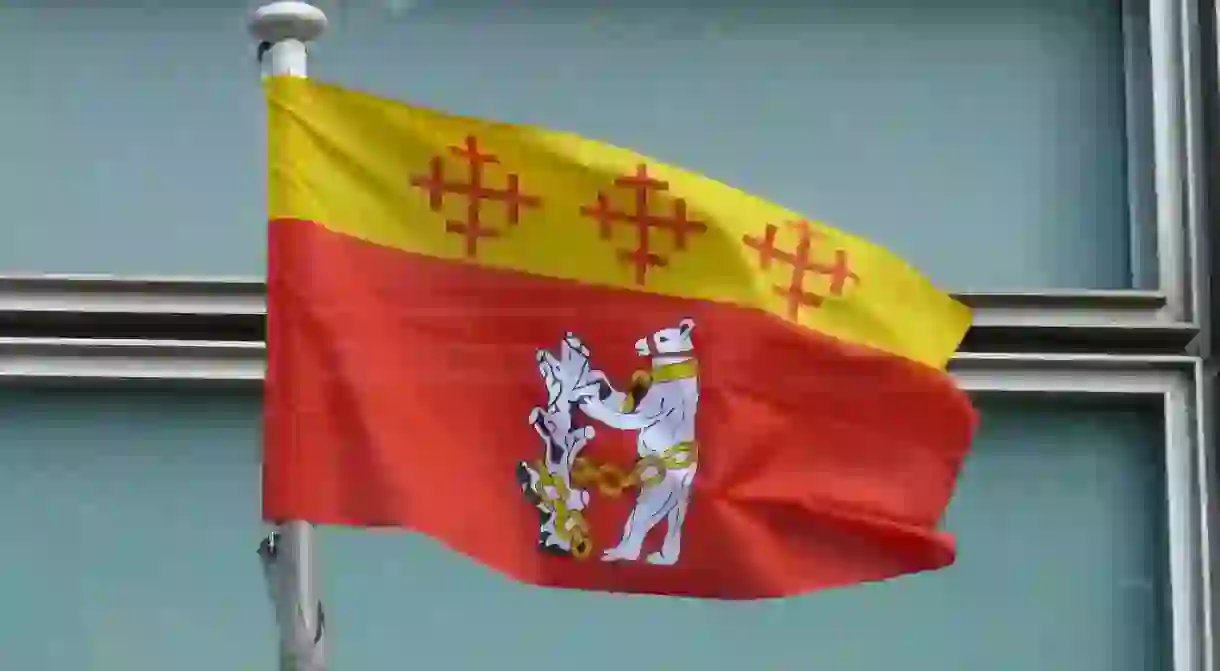Why is There a Bear on Warwickshire's Flag?

A flag must convey a place’s identity. When recently deciding upon its county flag, the Warwickshire Council went for a ‘Bear and Ragged Staff’, incorporating symbolism that can be seen all throughout the region. But what is the imagery’s origin?
Great Britain is made up of 86 counties, which each traditionally have had their own emblematic associations tied to heraldic histories. It was only with the establishment of the Flag Institute in 1971 that a uniform, formal registry was initiated through which each county’s flag could be confirmed. Not all counties have registered one yet, and many rely simply on the county council’s crest. These crests don’t necessarily contain the same imagery as the flag in counties which have both.
Warwickshire, which only had its current boundaries set in 1974, looked to history when deciding on the design of its flag and took inspiration from its crest. The Warwickshire County Council has long used the imagery of a white bear, ragged staff and red background within the design of its crest.

The first recorded instance of this symbol being used can be found in the original seal and crest of the Earl of Warwick, designed before the fourteenth century. One suggestion has been that an early Earl of Warwick killed a bear with a broken piece of wood, but this doesn’t explain the fact that the bear is shown chained in the historic versions of the image.
The most commonly accepted explanation lies in the story that Henri de Beaumont, who was made the first Earl of Warwick in 1088, may have had a bear and ragged staff upon his family crest. This attribution to the very first Earl would explain the imagery’s deep roots and recurring appearance in the county’s history. However, another theory states that the de Beaumont family adapted the bear and staff, which was already embedded in local tradition, into their family crest as a result of their ties to the county. This would mean its iconography stretched back even further; unfortunately, concrete evidence of this hasn’t been recovered. The meaning of the flag can only be discussed in terms of tales and legends.

This hasn’t prevented the symbol’s continued widespread use, both of the original imagery and modern variations. The Warwickshire Fire and Rescue Service use a version of the original, still including the chains, whereas the police have taken a more modern approach, excluding the chains. Upon the tomb of Robert Dudley, the first Earl of Leicester, in St Mary’s, a metal bear and ragged staff can be found. At the feet of his brother Ambrose Dudley’s tomb, the bear in chains features without the staff.

A statue at Kenilworth Castle includes the traditional chains. The county council’s coat of arms still includes the chains, but its modernised logo, far more commonly used, features a stylisation without them. Beyond these more traditional uses of the icon, there are also pubs all across Warwickshire called The Bear and Ragged Staff, and there’s even a real bear in the Warwickshire Museum which has been stuffed and positioned with a staff in its paw. There’s no restriction on using the symbol as long as the colouring is different to that used by the county council or the Earl of Warwick.
The bear and the ragged staff is a motif that has appeared over centuries in Warwickshire, and so the choice seemed obvious when the campaign began in 2014 for Warwickshire to have its own flag. In 2016, Warwickshire registered the symbol that is still used today with the Flag Institute, paying homage to the fundamental heraldic history of the area.
This article was written in association with The Boar, a student publication based at the University of Warwick.













